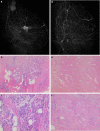Accuracy of magnetic resonance imaging for predicting pathological complete response of breast cancer after neoadjuvant chemotherapy: association with breast cancer subtype
- PMID: 27026849
- PMCID: PMC4766139
- DOI: 10.1186/s40064-016-1800-x
Accuracy of magnetic resonance imaging for predicting pathological complete response of breast cancer after neoadjuvant chemotherapy: association with breast cancer subtype
Abstract
A pathological complete response (pCR) to neoadjuvant chemotherapy (NAC) is a signature of favorable prognosis in breast cancer. The aim of this study was to assess the accuracy of magnetic resonance imaging (MRI) in predicting the pCR after NAC. 265 women with stage II or III breast cancer who underwent surgery after NAC were retrospectively investigated for MRI findings before and after the NAC. Correlation of pCR with an "imaging complete response" (iCR), defined as no detectable tumor on all serial images with dynamic contrast-enhanced T1-weighted imaging, was evaluated with respect to each tumor subtype. Of 265 cases, 44 (16.6 %) and 24 (9.1 %) were diagnosed as iCR and pCR, respectively. Nineteen of the 44 iCR cases (43.2 %) were assessed as pCR, and 216 (97.7 %) of the 221 non-iCR cases were assessed as non-pCR. The accuracy (ACC), the pCR predictive value (PPV) and the non-pCR predictive value (NPV) were 88.7, 43.2, and 97.7 %, respectively. When assessed according to each tumor subtype, the ACC, PPV and NPV were 93.2, 21.4 and 100 % for luminal subtype, 70.8, 0 and 89.5 % for luminal/HER2 subtype, 75, 57.1 and 88.8 % for HER2-enriched subtype, and 90.9, 72.7 and 97 % for triple-negative subtype, respectively. MRI is a valuable modality for predicting pCR of breast cancer after NAC treatment. However, its accuracy varies greatly in different breast cancer subtypes. Whereas MRI closely predicts pCR in the triple-negative subtype, iCR in the luminal subtype is often an over-estimation. On the other hand, residual lesions identified by MRI are reliable markers of non-pCR for the luminal subtype.
Keywords: Breast cancer; Breast cancer subtype; Imaging complete response (iCR); Magnetic resonance imaging (MRI); Neoadjuvant chemotherapy (NAC); Pathological complete response (pCR).
Figures



References
-
- Bear HD, Anderson S, Smith RE, Geyer CE, Jr, Mamounas EP, Fisher B, et al. Sequential preoperative or postoperative docetaxel added to preoperative doxorubicin plus cyclophosphamide for operable breast cancer: National Surgical Adjuvant Breast and Bowel Project Protocol B-27. J Clin Oncol. 2006;24:2019–2027. doi: 10.1200/JCO.2005.04.1665. - DOI - PubMed
-
- De Los Santos J, Bernreuter W, Keene K, Krontiras H, Carpenter J, Bland K, et al. Accuracy of breast magnetic resonance imaging in predicting pathologic response in patients treated with neoadjuvant chemotherapy. Clin Breast Cancer. 2011;11(5):312–319. doi: 10.1016/j.clbc.2011.06.007. - DOI - PubMed
LinkOut - more resources
Full Text Sources
Other Literature Sources
Research Materials
Miscellaneous

